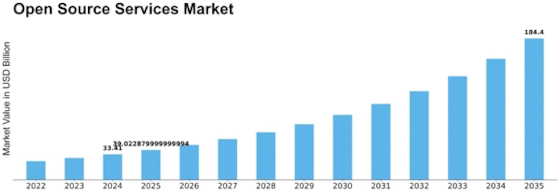Consulting Services
Support Services
Training Services
Development Services
Small and Medium Enterprises
Large Enterprises
Government Organizations
Academic Institutions
On-Premises
Cloud-Based
Hybrid
Information Technology
Healthcare
Education
Finance
North America
Europe
South America
Asia Pacific
Middle East and Africa
North America Outlook (USD Billion, 2019-2035)
North America Open Source Services Market by Service Type
Consulting Services
Support Services
Training Services
Development Services
North America Open Source Services Market by End User Type
Small and Medium Enterprises
Large Enterprises
Government Organizations
Academic Institutions
North America Open Source Services Market by Deployment Model Type
On-Premises
Cloud-Based
Hybrid
North America Open Source Services Market by Industry Type
Information Technology
Healthcare
Education
Finance
North America Open Source Services Market by Regional Type
US
Canada
US Outlook (USD Billion, 2019-2035)
US Open Source Services Market by Service Type
Consulting Services
Support Services
Training Services
Development Services
US Open Source Services Market by End User Type
Small and Medium Enterprises
Large Enterprises
Government Organizations
Academic Institutions
US Open Source Services Market by Deployment Model Type
On-Premises
Cloud-Based
Hybrid
US Open Source Services Market by Industry Type
Information Technology
Healthcare
Education
Finance
CANADA Outlook (USD Billion, 2019-2035)
CANADA Open Source Services Market by Service Type
Consulting Services
Support Services
Training Services
Development Services
CANADA Open Source Services Market by End User Type
Small and Medium Enterprises
Large Enterprises
Government Organizations
Academic Institutions
CANADA Open Source Services Market by Deployment Model Type
On-Premises
Cloud-Based
Hybrid
CANADA Open Source Services Market by Industry Type
Information Technology
Healthcare
Education
Finance
Europe Outlook (USD Billion, 2019-2035)
Europe Open Source Services Market by Service Type
Consulting Services
Support Services
Training Services
Development Services
Europe Open Source Services Market by End User Type
Small and Medium Enterprises
Large Enterprises
Government Organizations
Academic Institutions
Europe Open Source Services Market by Deployment Model Type
On-Premises
Cloud-Based
Hybrid
Europe Open Source Services Market by Industry Type
Information Technology
Healthcare
Education
Finance
Europe Open Source Services Market by Regional Type
Germany
UK
France
Russia
Italy
Spain
Rest of Europe
GERMANY Outlook (USD Billion, 2019-2035)
GERMANY Open Source Services Market by Service Type
Consulting Services
Support Services
Training Services
Development Services
GERMANY Open Source Services Market by End User Type
Small and Medium Enterprises
Large Enterprises
Government Organizations
Academic Institutions
GERMANY Open Source Services Market by Deployment Model Type
On-Premises
Cloud-Based
Hybrid
GERMANY Open Source Services Market by Industry Type
Information Technology
Healthcare
Education
Finance
UK Outlook (USD Billion, 2019-2035)
UK Open Source Services Market by Service Type
Consulting Services
Support Services
Training Services
Development Services
UK Open Source Services Market by End User Type
Small and Medium Enterprises
Large Enterprises
Government Organizations
Academic Institutions
UK Open Source Services Market by Deployment Model Type
On-Premises
Cloud-Based
Hybrid
UK Open Source Services Market by Industry Type
Information Technology
Healthcare
Education
Finance
FRANCE Outlook (USD Billion, 2019-2035)
FRANCE Open Source Services Market by Service Type
Consulting Services
Support Services
Training Services
Development Services
FRANCE Open Source Services Market by End User Type
Small and Medium Enterprises
Large Enterprises
Government Organizations
Academic Institutions
FRANCE Open Source Services Market by Deployment Model Type
On-Premises
Cloud-Based
Hybrid
FRANCE Open Source Services Market by Industry Type
Information Technology
Healthcare
Education
Finance
RUSSIA Outlook (USD Billion, 2019-2035)
RUSSIA Open Source Services Market by Service Type
Consulting Services
Support Services
Training Services
Development Services
RUSSIA Open Source Services Market by End User Type
Small and Medium Enterprises
Large Enterprises
Government Organizations
Academic Institutions
RUSSIA Open Source Services Market by Deployment Model Type
On-Premises
Cloud-Based
Hybrid
RUSSIA Open Source Services Market by Industry Type
Information Technology
Healthcare
Education
Finance
ITALY Outlook (USD Billion, 2019-2035)
ITALY Open Source Services Market by Service Type
Consulting Services
Support Services
Training Services
Development Services
ITALY Open Source Services Market by End User Type
Small and Medium Enterprises
Large Enterprises
Government Organizations
Academic Institutions
ITALY Open Source Services Market by Deployment Model Type
On-Premises
Cloud-Based
Hybrid
ITALY Open Source Services Market by Industry Type
Information Technology
Healthcare
Education
Finance
SPAIN Outlook (USD Billion, 2019-2035)
SPAIN Open Source Services Market by Service Type
Consulting Services
Support Services
Training Services
Development Services
SPAIN Open Source Services Market by End User Type
Small and Medium Enterprises
Large Enterprises
Government Organizations
Academic Institutions
SPAIN Open Source Services Market by Deployment Model Type
On-Premises
Cloud-Based
Hybrid
SPAIN Open Source Services Market by Industry Type
Information Technology
Healthcare
Education
Finance
REST OF EUROPE Outlook (USD Billion, 2019-2035)
REST OF EUROPE Open Source Services Market by Service Type
Consulting Services
Support Services
Training Services
Development Services
REST OF EUROPE Open Source Services Market by End User Type
Small and Medium Enterprises
Large Enterprises
Government Organizations
Academic Institutions
REST OF EUROPE Open Source Services Market by Deployment Model Type
On-Premises
Cloud-Based
Hybrid
REST OF EUROPE Open Source Services Market by Industry Type
Information Technology
Healthcare
Education
Finance
APAC Outlook (USD Billion, 2019-2035)
APAC Open Source Services Market by Service Type
Consulting Services
Support Services
Training Services
Development Services
APAC Open Source Services Market by End User Type
Small and Medium Enterprises
Large Enterprises
Government Organizations
Academic Institutions
APAC Open Source Services Market by Deployment Model Type
On-Premises
Cloud-Based
Hybrid
APAC Open Source Services Market by Industry Type
Information Technology
Healthcare
Education
Finance
APAC Open Source Services Market by Regional Type
China
India
Japan
South Korea
Malaysia
Thailand
Indonesia
Rest of APAC
CHINA Outlook (USD Billion, 2019-2035)
CHINA Open Source Services Market by Service Type
Consulting Services
Support Services
Training Services
Development Services
CHINA Open Source Services Market by End User Type
Small and Medium Enterprises
Large Enterprises
Government Organizations
Academic Institutions
CHINA Open Source Services Market by Deployment Model Type
On-Premises
Cloud-Based
Hybrid
CHINA Open Source Services Market by Industry Type
Information Technology
Healthcare
Education
Finance
INDIA Outlook (USD Billion, 2019-2035)
INDIA Open Source Services Market by Service Type
Consulting Services
Support Services
Training Services
Development Services
INDIA Open Source Services Market by End User Type
Small and Medium Enterprises
Large Enterprises
Government Organizations
Academic Institutions
INDIA Open Source Services Market by Deployment Model Type
On-Premises
Cloud-Based
Hybrid
INDIA Open Source Services Market by Industry Type
Information Technology
Healthcare
Education
Finance
JAPAN Outlook (USD Billion, 2019-2035)
JAPAN Open Source Services Market by Service Type
Consulting Services
Support Services
Training Services
Development Services
JAPAN Open Source Services Market by End User Type
Small and Medium Enterprises
Large Enterprises
Government Organizations
Academic Institutions
JAPAN Open Source Services Market by Deployment Model Type
On-Premises
Cloud-Based
Hybrid
JAPAN Open Source Services Market by Industry Type
Information Technology
Healthcare
Education
Finance
SOUTH KOREA Outlook (USD Billion, 2019-2035)
SOUTH KOREA Open Source Services Market by Service Type
Consulting Services
Support Services
Training Services
Development Services
SOUTH KOREA Open Source Services Market by End User Type
Small and Medium Enterprises
Large Enterprises
Government Organizations
Academic Institutions
SOUTH KOREA Open Source Services Market by Deployment Model Type
On-Premises
Cloud-Based
Hybrid
SOUTH KOREA Open Source Services Market by Industry Type
Information Technology
Healthcare
Education
Finance
MALAYSIA Outlook (USD Billion, 2019-2035)
MALAYSIA Open Source Services Market by Service Type
Consulting Services
Support Services
Training Services
Development Services
MALAYSIA Open Source Services Market by End User Type
Small and Medium Enterprises
Large Enterprises
Government Organizations
Academic Institutions
MALAYSIA Open Source Services Market by Deployment Model Type
On-Premises
Cloud-Based
Hybrid
MALAYSIA Open Source Services Market by Industry Type
Information Technology
Healthcare
Education
Finance
THAILAND Outlook (USD Billion, 2019-2035)
THAILAND Open Source Services Market by Service Type
Consulting Services
Support Services
Training Services
Development Services
THAILAND Open Source Services Market by End User Type
Small and Medium Enterprises
Large Enterprises
Government Organizations
Academic Institutions
THAILAND Open Source Services Market by Deployment Model Type
On-Premises
Cloud-Based
Hybrid
THAILAND Open Source Services Market by Industry Type
Information Technology
Healthcare
Education
Finance
INDONESIA Outlook (USD Billion, 2019-2035)
INDONESIA Open Source Services Market by Service Type
Consulting Services
Support Services
Training Services
Development Services
INDONESIA Open Source Services Market by End User Type
Small and Medium Enterprises
Large Enterprises
Government Organizations
Academic Institutions
INDONESIA Open Source Services Market by Deployment Model Type
On-Premises
Cloud-Based
Hybrid
INDONESIA Open Source Services Market by Industry Type
Information Technology
Healthcare
Education
Finance
REST OF APAC Outlook (USD Billion, 2019-2035)
REST OF APAC Open Source Services Market by Service Type
Consulting Services
Support Services
Training Services
Development Services
REST OF APAC Open Source Services Market by End User Type
Small and Medium Enterprises
Large Enterprises
Government Organizations
Academic Institutions
REST OF APAC Open Source Services Market by Deployment Model Type
On-Premises
Cloud-Based
Hybrid
REST OF APAC Open Source Services Market by Industry Type
Information Technology
Healthcare
Education
Finance
South America Outlook (USD Billion, 2019-2035)
South America Open Source Services Market by Service Type
Consulting Services
Support Services
Training Services
Development Services
South America Open Source Services Market by End User Type
Small and Medium Enterprises
Large Enterprises
Government Organizations
Academic Institutions
South America Open Source Services Market by Deployment Model Type
On-Premises
Cloud-Based
Hybrid
South America Open Source Services Market by Industry Type
Information Technology
Healthcare
Education
Finance
South America Open Source Services Market by Regional Type
Brazil
Mexico
Argentina
Rest of South America
BRAZIL Outlook (USD Billion, 2019-2035)
BRAZIL Open Source Services Market by Service Type
Consulting Services
Support Services
Training Services
Development Services
BRAZIL Open Source Services Market by End User Type
Small and Medium Enterprises
Large Enterprises
Government Organizations
Academic Institutions
BRAZIL Open Source Services Market by Deployment Model Type
On-Premises
Cloud-Based
Hybrid
BRAZIL Open Source Services Market by Industry Type
Information Technology
Healthcare
Education
Finance
MEXICO Outlook (USD Billion, 2019-2035)
MEXICO Open Source Services Market by Service Type
Consulting Services
Support Services
Training Services
Development Services
MEXICO Open Source Services Market by End User Type
Small and Medium Enterprises
Large Enterprises
Government Organizations
Academic Institutions
MEXICO Open Source Services Market by Deployment Model Type
On-Premises
Cloud-Based
Hybrid
MEXICO Open Source Services Market by Industry Type
Information Technology
Healthcare
Education
Finance
ARGENTINA Outlook (USD Billion, 2019-2035)
ARGENTINA Open Source Services Market by Service Type
Consulting Services
Support Services
Training Services
Development Services
ARGENTINA Open Source Services Market by End User Type
Small and Medium Enterprises
Large Enterprises
Government Organizations
Academic Institutions
ARGENTINA Open Source Services Market by Deployment Model Type
On-Premises
Cloud-Based
Hybrid
ARGENTINA Open Source Services Market by Industry Type
Information Technology
Healthcare
Education
Finance
REST OF SOUTH AMERICA Outlook (USD Billion, 2019-2035)
REST OF SOUTH AMERICA Open Source Services Market by Service Type
Consulting Services
Support Services
Training Services
Development Services
REST OF SOUTH AMERICA Open Source Services Market by End User Type
Small and Medium Enterprises
Large Enterprises
Government Organizations
Academic Institutions
REST OF SOUTH AMERICA Open Source Services Market by Deployment Model Type
On-Premises
Cloud-Based
Hybrid
REST OF SOUTH AMERICA Open Source Services Market by Industry Type
Information Technology
Healthcare
Education
Finance
MEA Outlook (USD Billion, 2019-2035)
MEA Open Source Services Market by Service Type
Consulting Services
Support Services
Training Services
Development Services
MEA Open Source Services Market by End User Type
Small and Medium Enterprises
Large Enterprises
Government Organizations
Academic Institutions
MEA Open Source Services Market by Deployment Model Type
On-Premises
Cloud-Based
Hybrid
MEA Open Source Services Market by Industry Type
Information Technology
Healthcare
Education
Finance
MEA Open Source Services Market by Regional Type
GCC Countries
South Africa
Rest of MEA
GCC COUNTRIES Outlook (USD Billion, 2019-2035)
GCC COUNTRIES Open Source Services Market by Service Type
Consulting Services
Support Services
Training Services
Development Services
GCC COUNTRIES Open Source Services Market by End User Type
Small and Medium Enterprises
Large Enterprises
Government Organizations
Academic Institutions
GCC COUNTRIES Open Source Services Market by Deployment Model Type
On-Premises
Cloud-Based
Hybrid
GCC COUNTRIES Open Source Services Market by Industry Type
Information Technology
Healthcare
Education
Finance
SOUTH AFRICA Outlook (USD Billion, 2019-2035)
SOUTH AFRICA Open Source Services Market by Service Type
Consulting Services
Support Services
Training Services
Development Services
SOUTH AFRICA Open Source Services Market by End User Type
Small and Medium Enterprises
Large Enterprises
Government Organizations
Academic Institutions
SOUTH AFRICA Open Source Services Market by Deployment Model Type
On-Premises
Cloud-Based
Hybrid
SOUTH AFRICA Open Source Services Market by Industry Type
Information Technology
Healthcare
Education
Finance
REST OF MEA Outlook (USD Billion, 2019-2035)
REST OF MEA Open Source Services Market by Service Type
Consulting Services
Support Services
Training Services
Development Services
REST OF MEA Open Source Services Market by End User Type
Small and Medium Enterprises
Large Enterprises
Government Organizations
Academic Institutions
REST OF MEA Open Source Services Market by Deployment Model Type
On-Premises
Cloud-Based
Hybrid
REST OF MEA Open Source Services Market by Industry Type
Information Technology
Healthcare
Education
Finance










Leave a Comment